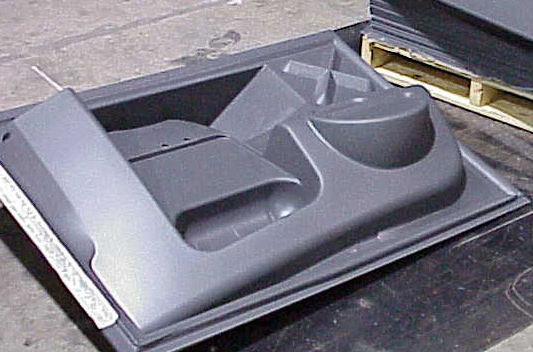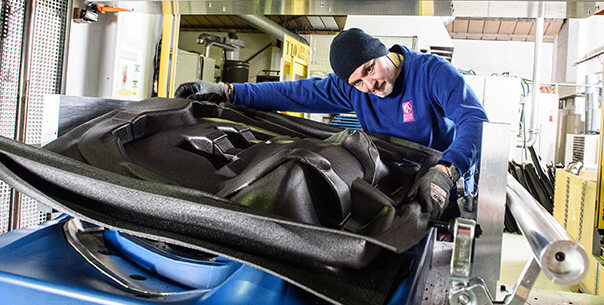Yes, PVC sheets can be effectively vacuum formed for various applications.
Vacuum Forming PVC Sheets
Vacuum forming is a popular and cost-effective method of shaping plastic sheets, and PVC (Polyvinyl Chloride) is a widely used material in this process due to its versatility and durability. This section delves into the essential aspects of vacuum forming PVC sheets, from understanding the properties of PVC to preparing the sheets for the forming process.

Properties of PVC Sheets in Vacuum Forming
PVC sheets exhibit unique characteristics when subjected to vacuum forming. Their high impact strength and good rigidity make them suitable for a variety of applications. Additionally, the thermal stability of PVC allows for uniform heating and forming, ensuring consistent quality in the final product. Understanding these properties is essential for selecting the right type of PVC sheet for specific vacuum forming projects.
Preparing PVC Sheets for Vacuum Forming
Proper preparation of PVC sheets is critical for successful vacuum forming. Begin by cutting the PVC sheets to the required size, ensuring that dimensions and specifications match the project needs. Preheating the PVC sheets to a temperature between 160°C and 180°C is crucial for making them pliable enough for forming. It’s important to monitor the temperature closely to prevent overheating, which can degrade the material’s quality.
The vacuum forming process involves placing the heated PVC sheet over a mold and applying vacuum to shape the sheet into the desired form. Once formed, the PVC sheet needs to cool down to retain its new shape.
Step-by-Step Guide to Vacuum Forming PVC
Vacuum forming PVC is a versatile and efficient method for creating shaped plastic parts. This guide provides a detailed overview of the equipment and tools required, as well as the step-by-step process to vacuum form PVC effectively.
Equipment and Tools Required
The success of vacuum forming PVC largely depends on having the right equipment and tools. Here’s a list of essential items:
- Vacuum Forming Machine: This is the core equipment. Machines with a power range of 2 to 5 kW are common for small to medium projects.
- PVC Sheets: The material to be formed. Thickness varies based on the project, typically ranging from 0.5mm to 6mm.
- Mold: Molds can be made from various materials like wood, aluminum, or resin.
- Heating System: To soften the PVC sheets. The system should evenly distribute heat across the sheet.
- Vacuum Pump: Essential for creating the vacuum. A pump with a capacity of 10 to 25 inches of mercury is sufficient for most projects.
- Thermometer or Pyrometer: For accurately measuring the temperature of PVC sheets.
- Cutting Tools: For trimming the formed PVC.
Process Steps for Vacuum Forming PVC
The vacuum forming process involves several detailed steps, which are crucial for achieving the desired outcome:
- Preparing the Mold
- Ensure the mold is clean and free from any debris.
- If necessary, apply a release agent to facilitate easier removal of the PVC after forming.
- Heating the PVC Sheet
- Place the PVC sheet in the vacuum forming machine.
- Heat the sheet to its forming temperature, typically between 160°C and 180°C.
- Monitor the sheet to avoid overheating, which can cause degradation.
- Forming the PVC
- Once the PVC reaches the desired temperature, quickly transfer it to the mold.
- Activate the vacuum pump to form the sheet around the mold.
- The vacuum should be maintained until the PVC cools and solidifies, ensuring accurate shape formation.
- Cooling and Removing the Formed PVC
- Allow the PVC to cool on the mold. This can take several minutes depending on the thickness.
- After cooling, gently remove the formed PVC from the mold.
- Trimming and Finishing
- Trim any excess material using cutting tools.
- Additional finishing processes like sanding or painting can be applied if required.
Troubleshooting Common Issues
In the process of vacuum forming PVC, several issues can arise that affect the quality of the final product. Two of the most common problems are warping and the formation of bubbles, as well as challenges in achieving uniform thickness and finish. Addressing these issues promptly and effectively is crucial to ensure high-quality results.
Addressing Warping and Bubbles
Warping and bubbles in vacuum formed PVC can compromise the structural integrity and aesthetic of the product. Here are ways to address these issues:
- Preventing Warping:
- Even Heating: Ensure the PVC sheet is heated evenly. Uneven heating often leads to warping.
- Proper Cooling: Allow the PVC to cool gradually on the mold. Rapid or uneven cooling can cause warping.
- Mold Design: Design the mold to support the PVC sheet adequately during forming and cooling.
- Eliminating Bubbles:
- Check for Moisture: Ensure that the PVC sheets are dry. Moisture trapped in the sheets can turn into steam, creating bubbles.
- Optimal Heating Temperature: Overheating can cause the PVC to blister and form bubbles. Maintain the correct temperature range.
- Vacuum Integrity: Ensure that the vacuum forming machine provides a consistent and strong vacuum to avoid air pockets.
Ensuring Uniform Thickness and Finish
Achieving uniform thickness and a smooth finish in vacuum formed products is essential for both aesthetic and functional reasons. Here’s how to ensure these qualities:
- Consistent Sheet Thickness: Use PVC sheets with consistent thickness. Variations in the sheet thickness can lead to uneven forming.
- Adequate Vacuum Pressure: Ensure the vacuum forming machine provides adequate and even pressure during the forming process. This helps in achieving uniform thickness.
- Mold Precision: The precision of the mold greatly influences the final finish of the product. A well-designed and smooth mold surface will result in a better finish.
- Post-Forming Processes: Sometimes, additional processes like sanding or polishing are required to achieve the desired finish on the PVC product.
Maintaining and Cleaning PVC Products
Proper maintenance and cleaning are vital for extending the lifespan of vacuum formed PVC products. Implementing best practices for longevity and knowing how to clean and repair these products can significantly enhance their durability and appearance.
Best Practices for Longevity
Maintaining PVC products involves several key practices that help in preserving their quality and extending their lifespan:
- Avoid Prolonged Sun Exposure: Continuous exposure to sunlight can cause PVC to become brittle. Limiting sun exposure extends the product’s life.
- Regular Cleaning: Regular cleaning prevents the buildup of dirt and grime, which can degrade the material over time.
- Proper Storage: Store PVC products in a cool, dry place to prevent warping and moisture damage.
- Avoid Harsh Chemicals: Using harsh cleaning agents can damage the surface of PVC. Stick to mild detergents for cleaning.

Cleaning and Repairing Vacuum Formed PVC Products
Cleaning and repairing PVC products are straightforward but require attention to detail to avoid damaging the material.
Wipe with Soft Cloth: Use a soft, non-abrasive cloth to wipe the surface.
Use Mild Detergents: Clean with mild detergents mixed in water. Avoid using solvents or abrasive cleaners.
Rinse with Water: After cleaning, rinse the surface with clean water to remove any soap residue.
Dry Thoroughly: Dry the surface with a clean, dry cloth to prevent water spots.
Repairing Minor Damage:
Small Cracks or Scratches: Fill small cracks or scratches with a PVC-compatible filler. After drying, sand the area gently for a smooth finish.
Reattaching Parts: Use PVC cement for reattaching broken parts. Ensure a strong bond by applying the cement evenly.




